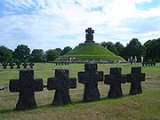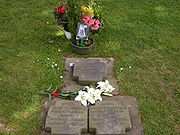
La Cambe
Encyclopedia
La Cambe is a military
war grave
cemetery
, located close to Bayeux
, France
. Presently containing in excess of 21,000 German
military personnel of World War II
, it is maintained and managed by the German War Graves Commission
.
Graves Registration Service during the war, where American and German soldiers, sailors and airmen were buried in two adjacent fields.
After the war had ended on the continent and paralleling the work undertaken to repair all the devastation that the war had caused, work began on exhuming the American remains and transferring them in accordance with the wishes of their families. Beginning in 1945, the Americans transferred two-thirds of their fallen from this site back to the United States while the remainder were reinterred at the new permanent American Cemetery and Memorial at Colleville-sur-Mer
, which overlooks the Omaha Beach
landing site.
Because of the pace of the war, the German war dead in Normandy were scattered over a wide area, many of them buried in isolated field graves - or small battlefield cemeteries. In the years following the war, the German War Graves Commission (Volksbund Deutsche Kriegsgräberfürsorge) sought to establish six main German cemeteries in the Normandy area.
 La Cambe, as an existing site of German war dead that was already informally cared for by the German War Graves Commission, was a natural choice for one of the six formal sites. After the signing in 1954 of the Franco-German Treaty on War Graves, La Combe was formally cared for, allowing the remains of 12,000 German soldiers to be moved in from 1,400 locations in the French departments of Calvados and the Orne.
La Cambe, as an existing site of German war dead that was already informally cared for by the German War Graves Commission, was a natural choice for one of the six formal sites. After the signing in 1954 of the Franco-German Treaty on War Graves, La Combe was formally cared for, allowing the remains of 12,000 German soldiers to be moved in from 1,400 locations in the French departments of Calvados and the Orne.
La Cambe was officially inaugurated as a German War Cemetery in September 1961. Since that date, the remains of more than 700 soldiers have been found on battlefields across Normandy, and reinterred at La Cambe.
Layout and landscaping of the site began immediately after formal handover, which today has created at its centre a large tumulus
, flanked by statues and topped by a large dark cross, which marks the resting place for 207 unknown and 89 identified German soldiers, interred together in a mass grave. The sign in front of the cemetery reads as follows:
 The majority of the German war dead buried at La Cambe fell between June 6 and August 20, 1944 and their ages range from 16 to 72. They died during the Allied landings and the ensuing combat. Their ranks include Tiger tank ace Michael Wittmann
The majority of the German war dead buried at La Cambe fell between June 6 and August 20, 1944 and their ages range from 16 to 72. They died during the Allied landings and the ensuing combat. Their ranks include Tiger tank ace Michael Wittmann
, who along with his tank crew was informally buried in an unmarked site following his death, only to be found in 1983 and reinterred together at La Cambe.
Since the mid-1990s, there has been an Information Center on the site, where visitors can view a permanent exhibition about the German War Graves Commission and access a database to search for the location of German military dead.
Unlike the American and Commonwealth War Graves Commission
s, the German Commission is entirely voluntary and relies on gifts and collections to further its work. During the summer months one may see German school children tending the graves; they volunteer to work with the Volksbund during their school holidays.
Military
A military is an organization authorized by its greater society to use lethal force, usually including use of weapons, in defending its country by combating actual or perceived threats. The military may have additional functions of use to its greater society, such as advancing a political agenda e.g...
war grave
War grave
A war grave is a burial place for soldiers or civilians who died during military campaigns or operations. The term does not only apply to graves: ships sunk during wartime are often considered to be war graves, as are military aircraft that crash into water...
cemetery
Cemetery
A cemetery is a place in which dead bodies and cremated remains are buried. The term "cemetery" implies that the land is specifically designated as a burying ground. Cemeteries in the Western world are where the final ceremonies of death are observed...
, located close to Bayeux
Bayeux
Bayeux is a commune in the Calvados department in Normandy in northwestern France.Bayeux is the home of the Bayeux Tapestry, which depicts the events leading up to the Norman conquest of England.-Administration:Bayeux is a sub-prefecture of Calvados...
, France
France
The French Republic , The French Republic , The French Republic , (commonly known as France , is a unitary semi-presidential republic in Western Europe with several overseas territories and islands located on other continents and in the Indian, Pacific, and Atlantic oceans. Metropolitan France...
. Presently containing in excess of 21,000 German
Germany
Germany , officially the Federal Republic of Germany , is a federal parliamentary republic in Europe. The country consists of 16 states while the capital and largest city is Berlin. Germany covers an area of 357,021 km2 and has a largely temperate seasonal climate...
military personnel of World War II
World War II
World War II, or the Second World War , was a global conflict lasting from 1939 to 1945, involving most of the world's nations—including all of the great powers—eventually forming two opposing military alliances: the Allies and the Axis...
, it is maintained and managed by the German War Graves Commission
German War Graves Commission
The German War Graves Commission is responsible for the maintenance and upkeep of German war graves in Europe and North Africa...
.
History
La Cambe was originally the site of a battlefield cemetery, established by the United States ArmyUnited States Army
The United States Army is the main branch of the United States Armed Forces responsible for land-based military operations. It is the largest and oldest established branch of the U.S. military, and is one of seven U.S. uniformed services...
Graves Registration Service during the war, where American and German soldiers, sailors and airmen were buried in two adjacent fields.
After the war had ended on the continent and paralleling the work undertaken to repair all the devastation that the war had caused, work began on exhuming the American remains and transferring them in accordance with the wishes of their families. Beginning in 1945, the Americans transferred two-thirds of their fallen from this site back to the United States while the remainder were reinterred at the new permanent American Cemetery and Memorial at Colleville-sur-Mer
Colleville-sur-Mer
Colleville-sur-Mer is a commune in the Calvados department in the Basse-Normandie region in northwestern France.The beach next to the coastal village was one of the principal beachheads during the Normandy landings on 6 June 1944, designated Omaha beach....
, which overlooks the Omaha Beach
Omaha Beach
Omaha Beach is the code name for one of the five sectors of the Allied invasion of German-occupied France in the Normandy landings on 6 June 1944, during World War II...
landing site.
Because of the pace of the war, the German war dead in Normandy were scattered over a wide area, many of them buried in isolated field graves - or small battlefield cemeteries. In the years following the war, the German War Graves Commission (Volksbund Deutsche Kriegsgräberfürsorge) sought to establish six main German cemeteries in the Normandy area.
Formation

La Cambe was officially inaugurated as a German War Cemetery in September 1961. Since that date, the remains of more than 700 soldiers have been found on battlefields across Normandy, and reinterred at La Cambe.
Layout and landscaping of the site began immediately after formal handover, which today has created at its centre a large tumulus
Tumulus
A tumulus is a mound of earth and stones raised over a grave or graves. Tumuli are also known as barrows, burial mounds, Hügelgrab or kurgans, and can be found throughout much of the world. A tumulus composed largely or entirely of stones is usually referred to as a cairn...
, flanked by statues and topped by a large dark cross, which marks the resting place for 207 unknown and 89 identified German soldiers, interred together in a mass grave. The sign in front of the cemetery reads as follows:

Michael Wittmann
Michael Wittmann was a German Waffen-SS tank commander during the Second World War. Wittmann would rise to the rank of SS-Hauptsturmführer and was a Knight's Cross of the Iron Cross holder....
, who along with his tank crew was informally buried in an unmarked site following his death, only to be found in 1983 and reinterred together at La Cambe.
Today
In total, as of July 2008, there are the remains of 21,222 German soldiers, sailors and airmen buried at La Cambe. Casualties of the war in Normandy are still being found after some 50 years, although formal burial ceremonies are less frequent these days.Since the mid-1990s, there has been an Information Center on the site, where visitors can view a permanent exhibition about the German War Graves Commission and access a database to search for the location of German military dead.
Unlike the American and Commonwealth War Graves Commission
Commonwealth War Graves Commission
The Commonwealth War Graves Commission is an intergovernmental organisation of six independent member states whose principal function is to mark, record and maintain the graves, and places of commemoration, of Commonwealth of Nations military service members who died in the two World Wars...
s, the German Commission is entirely voluntary and relies on gifts and collections to further its work. During the summer months one may see German school children tending the graves; they volunteer to work with the Volksbund during their school holidays.

